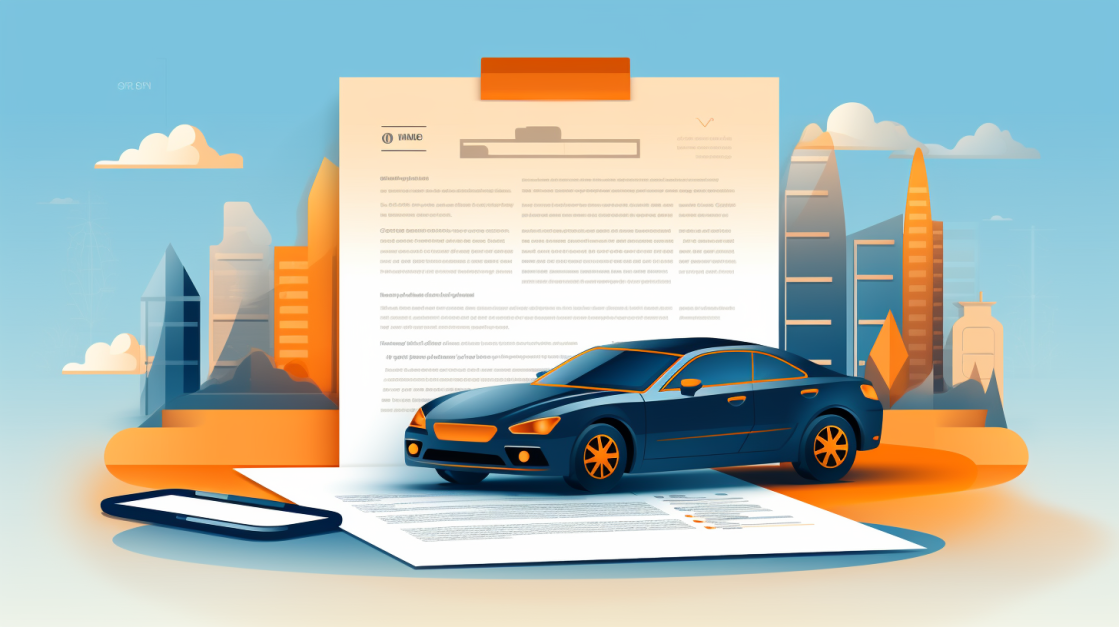Understanding the Fine Print of Auto Loan Debt

Overwhelmed by the tiny text and big legalese terms in your auto loan agreement? I hear you! Did you know, as per Experian, a major credit reporting agency, that the average new car loan in 2021 has hit nearly $35,000? That’s no small beans; it’s quite the financial pledge.
In this blog post, we’re going to take those fine print details that seem like Greek to most of us and break them down into bite-sized, easy-to-understand pieces. This will help you manage your auto debt load with greater confidence.
Let’s decipher this puzzle together!
Key Takeaways
- Auto loan debt is the money you owe for a car bought with borrowed funds. Interest rates and repaying rules add to this fee.
- Know key terms in auto loans like loan amount, interest rate, down payment, late fees, repayment terms and more. They help you handle your loan wisely.
- Watch out for risks when signing an auto loan agreement. High rates or hidden costs may make your deal costly.
- Boost credit scores by paying bills on time and less use of credit. Check quotes from different lenders to get best loan rates.
Understanding Auto Loan Debt
Auto loan debt is the money you owe after buying a car with borrowed funds. It refers to the sum borrowed for a car purchase but goes deeper than that. You see, interest rates and repayment plans add up on top of this amount.
To be wise about auto loan debt, get familiar with its parts. Key points are interest rate and loan term. The first is what lenders charge for giving out loans, acting like their profit from it.
While the latter shows how long you must repay your auto loan debt.
Also important are monthly payments plus any hidden fees which tend to sneak up on borrowers! These amounts can make or break one’s financial situation if they don’t plan well enough for them ahead of time.
Auto financing may seem complex at first, yet getting more insight into this topic helps in making smarter decisions when entering such agreements.
Key Terms in Loan Agreements

Digging deeper, we’ll cover must-know terms in auto loan agreements, like interest rate and collateral, so you feel prepared as you navigate your financial journey.
Loan Amount
The loan amount is the cash you get from a lender. It can be for buying a new car, used car or for paying off an old car loan. The cost of the vehicle usually sets the amount. But it might also include things like taxes and fees.
Some costs that came with your car could add to this number too.
Each lender has rules on how much they will lend out. These rules depend on many things, like credit score and how much the car costs in total. You must pay back every penny of this money over time as part of your monthly payments – just remember that! How much each month depends on how big the loan is at first.
Effective Date
The effective date matters a lot in a loan agreement. It tells us when our loan terms start to work. This date can change many parts of our deal such as interest rate, how we pay back the loan and penalties.
If there’s any mix-up with understanding this day, it may lead to shocks about the rules of our debts. So, I make sure to check and fully get what the effective date means before agreeing to any paper on auto loans.
Involved Parties
In an auto loan deal, some people play key roles. I am the borrower in this case. It’s my job to hand back all money lent to me with interest added on top. The lender is often a bank or car dealership who gives the money for the car purchase.
Sometimes there may be a co-signer too. If I fail to pay back my loan, they have to step in and take care of it for me.
Guarantor
A guarantor is a person who agrees to pay your loan if you can’t. They are a huge help in getting approval. Lenders feel more at ease giving money because they have someone else on the hook too.
Guarantors make it easy to get lower rates which saves you money over time. However, being a guarantor also has risks. If I don’t pay my debt, the burden falls on them which could hurt their credit score and financial health.
Down Payment
A down payment is the money you pay upfront for a car. This is your part of the car’s price in cash. It can lower the total loan amount, which means smaller monthly payments later on.
Usually, lenders want this to be 20% of the car’s cost.
You should save up enough before buying a new car. Making a large down payment decreases your financial strain over time. So, spend less than what you earn and put some cash aside every week or month!
Repayment Terms
Repayment terms mean how you will pay back your auto loan. They tell you how much to pay each month and for how long. Some loans last three years, others five or more! So pick wisely because longer terms can add up to higher costs over time due to interest.
Always be sure that your budget allows for these monthly payments before taking on any debt from a car loan.
Grace Period
A grace period is a time given after a loan payment due date. Within this span, you can still pay without getting late fees. Often, it’s between 10 to 15 days long. Grace periods help if money is tight or your payment gets delayed for reasons beyond control.
But make sure to not view this as extra time every month! Doing so can lead to bad credit scores and more debt trouble in the long-run.
Interest Rate
The interest rate is the money that you pay over time. It’s on top of the loan amount. The bank sets this rate and it can change much or little based on your credit score, market trends and loan term.
So, a high-interest rate means more money to pay back in total. Lower rates make loans cheaper in the end.
Collateral

In an auto loan, the car you buy is often the collateral. The lender can take this car if you don’t pay back the loan. This gives them a way to get their money back if things go wrong.
The value of your car plays a big part in how much money you can borrow. A more valuable car could mean a bigger loan and better terms. The lender looks at what your car is worth before they set up the loan deal.
Administrative Fees
Here’s the deal with administrative fees. They are extra amounts you have to pay for your auto loan debt. Lenders ask for this money to cover costs like looking at your loan application, getting papers set up and keeping track of the loan after they give it out.
Each lender has their own way of charging these fees, making it critical to read through every detail in your loan agreement. Checking the fine print can help you understand what each fee is about – whether they are application fees, document prep charges or costs related to servicing the existing debt.
Late Fees
You need to pay your auto loan on time. If you do not, late fees kick in. This is extra cash that the lender asks for as a penalty. Late fees can be a set amount of maybe $25 or $35.
They could also be a slice (2% to 5%) of the payment that came in too late. Missing payments often can result in big late fees piling up fast!
Prepayment Penalty
A prepayment penalty can cost you more when you pay off your loan early. It is like a fine that lenders charge. This fee is found in the small details of your loan contract. It isn’t easy to see, but it’s there.
Every time you want to pay some or all of your loan before its due date, you may have to pay this fee. Some states do not let lenders ask for these fees on auto loans and other loans too! So, always be sure about what will happen if you choose to repay the money sooner than planned.
Balloon Payment
A balloon payment is a large sum you have to pay at the end of an auto loan term. It’s often part of car loan agreements. This kind of payment helps keep your monthly payments low through the term of the loan.
But, you must make one big final payment.
This setup can be risky for some people with loans. It might seem nice to have smaller payments each month. Yet, it could be hard to come up with such a big amount at the end. Balloon payments let some people buy more pricey cars while keeping their monthly bills low.
However, this may not suit everyone’s budget or needs in the long run.
Default
Default happens if you can’t pay your car loan as agreed. The lender may take your car or charge extra fees. Your credit score will drop too, which makes future loans harder to get and more costly.
It is vital to avoid default by paying on time every month.
Cross-Default Provision
A cross-default provision is something you may find in your car loan agreement. It means if you miss a payment on any debt, not just your car loan, the lender can say you are at fault.
They can take legal steps and might even take back your car. So, it’s very important to read and understand all parts of the loan agreement before you sign anything!
Deferred Interest
Deferred Interest deals with your auto loan debt. It is when you do not pay interest for a set time, but it adds to the loan later. This could mean larger payments down the road. Be careful! A low payment now may cause bigger bills in the future.
Risks and Red Flags in Auto Loan Agreements

Just like any other deal, auto loans can have risks and red flags. High interest rates are a common risk. This means you pay more over time than what your car costs. Some lenders may also add hidden fees that drive up the real cost of the loan.
Another red flag is prepayment penalties. These charges come into play if you try to pay back the loan early to save on interest costs. Reading the fine print can help avoid these issues, but it’s not easy for all people to do.
Sometimes lenders will ask for more collateral or even cosigners on top of your new car – this raises risk levels even higher! Then there are clauses that let them take away your vehicle in some cases; another major warning sign for borrowers!
So I say be careful with auto loans – they’re great when done right but they hide traps which could hinder finances in long run!
How to Secure the Best Auto Loan Rate
Improving your credit score, researching and comparing loan quotes, and considering the total loan amount rather than just focusing on monthly payments can help secure the best auto loan rate.
Improve Credit Score
I am eager to share how we can improve our credit score. Making sure to pay all bills on time is the first step. We should never miss a payment date. Next, try to keep your use of credit below 30% of your total limit. This shows that we are not overly reliant on loans and credit cards. It’s also wise to check your credit reports regularly for mistakes. Blemishes on your report through no fault of your own can pull down your score. Aim for a mixture of credit type such as personal loans, car loans and home loans instead of just one type. A mix shows you can manage different kinds of debt together. Lastly, do not apply for new credit unless it’s really needed. Too many applications can make lenders think we’re desperate for cash.
Research and Compare Loan Quotes
You need to take your time and research when looking for an auto loan. Here are some steps that can help you:
- Collect quotes from different lenders or banks.
- Write down the interest rate for each offer.
- Look at the length of the loan, sometimes called the term.
- Note if there is a big fee you have to pay up front, referred to as an “origination fee”.
- Check if there are extra fees when you make a payment on time.
- Look at how much money you will pay over the whole length of the loan, not just monthly payments.
Consider the Total Loan Amount, not just Monthly Payment
Looking at the total loan amount is very important. We should not only focus on how much money we have to pay each month. This could lead us to pay more over time. The total loan amount includes the interest rates, length of the loan, and any extra fees or costs.
Reading and understanding all these details can be a big help. It can save us from surprise fees or penalties that make our loans cost more than we thought. By looking at the total loan amount, we can decide what is best for our wallets in the long run.
What to Do If the Loan Agreement Is Unfavorable
The loan agreement is an important contract. You need to know what to do if it does not favor you. Here are some things to keep in mind:
- Read the fine print: Know all the terms and conditions of the loan. This can help stop issues later.
- Seek legal advice: If parts of the agreement don’t make sense, ask a lawyer to look at it.
- Talk with a money expert: A financial expert can suggest ways to change the loan terms.
- Negotiate: Sometimes, banks might change some parts if you ask them to.
- Plan for higher rates: An unfavorable loan might mean paying more interest over time. Be ready for this cost.
- Think about changes down the road: Ask your bank what happens if you want to pay back early or if you miss a payment.
- Fix any problems quickly: The sooner you fix an issue, the better off your finances will be.
Conclusion
FAQs

1. What is an auto loan debt?
Auto loan debt happens when a financial institution lends money to buy a car. The borrower must repay this loan in installments over time, known as the duration of the loan.
2. What do terms like APR and Debt-to-income ratio mean?
APR means Annual Percentage Rate; it’s how much you pay each year in interest and fees. Debt-to-income ratio tells lenders if you can handle your financial obligation or risk defaulting on the payment.
3. Can someone explain my rights as a borrower?
As a borrower, you have many rights such as reading all the fine print on your contract, understanding all fees and costs including any hidden charges before signing for legal implications.
4. What happens if I don’t pay back my auto loan?
You will get charged late fee penalties by most lending institutions like Banks or Credit Unions that could harm your credit history with bureau reports.
5. Is any help available to understand my Auto Loan Agreement better?
Yes! You can get advice from Financial Counsellors who are experts in explaining complex matters related to creditworthiness, reviewing agreement documents—they make sure everything makes sense.
6.What is meant by “Fine Print” in an Auto Loan Debt Agreement?
The term “fine print” refers to conditions stated at end of agreements which include things like early repayment charges or altering adjustable rate loan (variable rate). This often requires careful reading for clarity,a comprehensive understanding reduces risk of oversights.






